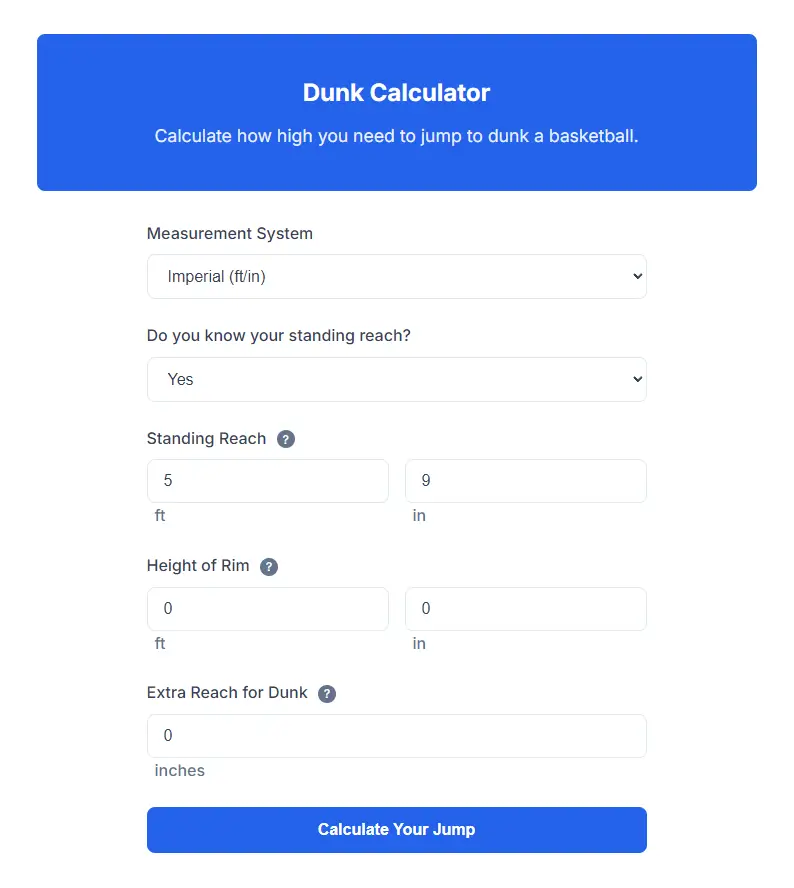Can You Dunk at 5'9? Vertical Jump Requirements Explained

If you're 5'9", the dream of dunking a basketball is absolutely within reach — but it all comes down to your vertical jump. For most people at this height, dunking typically requires a vertical leap of around 34 to 38 inches, depending on your standing reach and arm span.
That may sound like a big number, but don't be discouraged. Plenty of athletes — including Spud Webb and Nate Robinson — have proven that height isn't the deciding factor. The real question is: how high do you need to jump based on your own body measurements? That's where the numbers matter — and where this guide helps.
In this article, you'll learn:
- How to calculate your required vertical jump based on your height and reach
- Real examples of 5'9" athletes who successfully dunked
- What role standing reach plays — and how to measure it
- Simple steps to increase your vertical jump over time
You can also try our free Dunk Calculator to instantly find out how high you need to jump to dunk — based on your exact height and reach. Let's break it all down.
The Vertical Jump Math: How High Do You Really Need to Jump?
To dunk a standard 10-foot (120 inches) basketball hoop, your hand needs to reach at least 6 inches above the rim — that means about 126 inches (10'6") total reach at the peak of your jump.
Now let's break it down for someone who's 5'9" (69 inches tall):
- Typical standing reach: around 90 to 93 inches (varies by arm length)
- Required reach to dunk: 126 inches
- Needed vertical jump: ~33 to 36 inches
So yes — if you're 5'9" and can jump at least 34 inches vertically, dunking is within your grasp. Use our Dunk Calculator to enter your exact height and reach to get a precise number tailored to you.
Not Sure About Your Standing Reach?
That's okay — many people don't know it. In general, your standing reach is roughly 1.30 to 1.35× your height. But it can vary depending on wingspan and shoulder structure.
💡 Quick Tip: Measure Your Standing Reach
Try this quick method:
- Stand flat against a wall
- Reach up with one hand as high as possible
- Mark the spot and measure from the floor — that's your standing reach
Real Dunk Story: "I'm 5'9" and I Finally Dunked — Here's How I Did It"
Many players around 5'9" wonder if dunking is truly possible. This real story from a basketball forum shows the journey of one such player:
"I am 5'9, 16 yo. I have a 7'7" standing reach … I have a 29 in vert, I can touch a regular 10' rim with one hand. Dunking is one of my biggest dreams … based on your personal cases or experiences, do you think it's realistically possible for me to dunk …"
— u/WillItBePossible (r/BasketballTips)
The basketball community rallied with encouragement and practical advice:
"Yes you can bro … Everything is possible bro. Don't give up."
"If you train, it is very likely that you will be able to dunk. If you are willing to go to the gym, you can find free exercises online…"
Key Takeaways From This Success Story
- 🏀 Standing vertical of ~29" is a solid starting point—you're closer than you think
- 💪 Strength + plyometric training helped boost jump power
- ⏳ Consistent training over months produced impressive progress
- 👥 Community support and motivation played a crucial role
💡 Your Turn: Calculate Your Dunk Potential
Motivated by this story? Enter your own height and standing reach in our Dunk Calculator to see how close you are to dunking—then start creating your own success story!
What's Your Standing Reach — and Why It Matters More Than Height
While height is important, your standing reach — how high you can reach standing flat-footed — often plays an even bigger role in your dunk potential. Two players who are both 5'9" can have very different standing reaches depending on arm length and shoulder width.
To measure your standing reach at home:
- Stand flat against a wall with your feet shoulder-width apart.
- Extend one arm straight up as high as possible, keeping your feet flat on the ground.
- Mark the highest point you can touch on the wall.
- Measure from the floor to that mark — this is your standing reach.

Most 5'9" players have a standing reach between 7'5" and 7'8" (90" to 92"). The higher your standing reach, the less vertical leap you need to dunk. For example, a 5'9" player with a 7'8" standing reach needs roughly a 33-inch vertical to dunk, whereas one with a 7'5" reach may need 36 inches or more.
Understanding your standing reach lets you calculate your true vertical jump requirement more precisely. If you want an easy way to do this, check out our Standing Reach and Dunk Calculator that combines these metrics for instant results.
Real-Life Examples: People Who Dunked at 5'9" or Shorter
Still not convinced you can dunk at 5'9"? Here are real-world examples of athletes who proved it's possible — and how they did it.
1. Spud Webb (NBA Legend)
- Height: 5'7"
- Vertical: ~42 inches
- Highlight: Won the 1986 NBA Slam Dunk Contest
Spud Webb shocked the world with his leaping ability. He trained relentlessly with explosive plyometric routines, leg strength workouts, and perfect dunk timing.
2. Jordan Kilganon (Professional Dunker)
- Height: 6'1" but often trains athletes 5'9" and under
- Vertical: ~50 inches (standing + running)
Kilganon is known for coaching shorter athletes. His secret? Glute-dominant power drills and ultra-specific vertical jump periodization training.
3. "Dunkademics" Community Athletes
Plenty of amateur dunkers under 6 feet share their progress online. Many use bodyweight programs, smart nutrition, and patience to gain 8–12 inches of vertical in 6–12 months.
What These Dunkers All Had in Common
These successful shorter dunkers shared several key traits:
✔ They measured their progress weekly
✔ They followed science-based jump programs
✔ They optimized both strength & technique
✔ They developed proper approach and timing
These examples show that dunking at 5'9" isn't about magic — it's about method. Want to see where you stand? Use our Dunk Calculator to compare yourself to these jumpers.

How to Improve Your Vertical Jump If You're Close
If you're already close to the required vertical leap, focused training can help you cross the finish line. Here are five science-backed methods to boost your vertical jump effectively:
1. Strength Training with Squats and Deadlifts
Building leg strength is crucial. Deep squats and deadlifts target your glutes, hamstrings, and quads — the powerhouse muscles for jumping.
2. Plyometric Exercises
Exercises like box jumps, depth jumps, and bounding drills train your muscles to exert maximum force quickly, improving your explosive power.
3. Core Strengthening
A strong core stabilizes your body during takeoff and landing, reducing injury risk and enhancing jump efficiency.
4. Technique Refinement
Proper jumping mechanics, including arm swing coordination and foot placement, can add inches to your vertical.
5. Recovery and Nutrition
Rest, sleep, and proper nutrition — especially adequate protein and hydration — are essential for muscle growth and repair.
For a customized plan and progress tracking, use our Dunk Calculator along with the training tips outlined here to monitor your improvements.
FAQ: Quick Answers to Related Questions
Can a 5'7" person dunk?
A: Yes! A 5'7" person can dunk, but it usually requires a vertical jump of 42 inches or more. This is rare but achievable, as athletes like Spud Webb have shown by winning NBA dunk contests at that height.
What's the average vertical jump needed to dunk at my height?
A: For a 5'9" individual, a vertical jump between 35 to 40 inches is typically needed to dunk on a 10-foot rim. This varies with standing reach and arm length. Use our Dunk Calculator for precise results.
Does body weight affect dunking ability?
A: Yes, weight impacts your power-to-weight ratio. Extra body fat makes jumping harder, while good muscle strength improves explosive power. Optimal body composition helps maximize your vertical leap.
Can I dunk if I'm 15 years old or over 30?
A: Dunking is possible at almost any age. Teens benefit from natural growth, while adults over 30 need to focus on strength, flexibility, and recovery. Consistent, age-appropriate training is key.
How can I improve my vertical jump safely?
A: Focus on a balanced training program including strength exercises (like squats and deadlifts), plyometrics, flexibility, and proper rest. Avoid overtraining and warm up properly to reduce injury risk.
What role does technique play in dunking?
A: Technique is crucial. Proper jumping mechanics, foot placement, and timing maximize your power and efficiency, allowing you to jump higher with less effort.
Are there any training programs recommended for beginners?
A: Yes, beginners should start with basic strength training, mobility work, and low-impact plyometrics. Programs like Vert Shock or Jump Manual are popular for improving vertical jump safely over time.
Final Thoughts: Height Doesn't Define Your Dunk — Your Vertical Jump Does
Dunking at 5'9" is achievable if you focus on improving your vertical jump and understand your unique body metrics. Height alone is not destiny.
Use our Dunk Calculator now to see exactly how high you need to jump based on your height and standing reach. Combine that knowledge with consistent training and smart recovery, and your dunk could be closer than you think.
👉 Try our Dunk Calculator now to find out exactly how high you need to jump to dunk!
